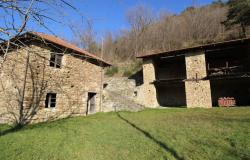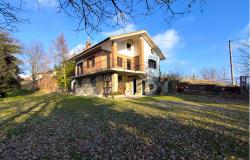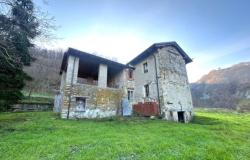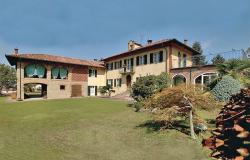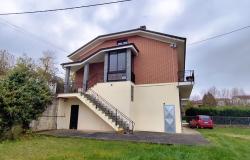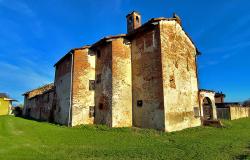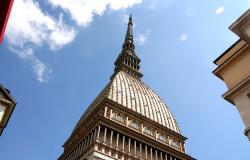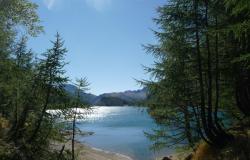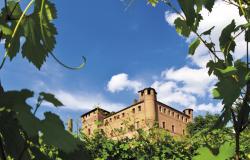Lago d’Orta lies less than 30 km from Stresa on Lago Maggiore, but seems a world away. In place of the grandiose and the fantastical, Orta is a lake of serenity, simplicity - and religious devotion. There are no coach parties here, no back-packers or conference hotels, and in the town of Orta San Giulio there aren’t even any cars. Only 8 miles long and 2 wide, Lago d’Orta is one of the smallest of the Italian Lakes. It’s also a lake that few people seem to have heard of and those of us who are regular visitors selfishly - and secretly - wish it could remain this way.
At the northern tip of the lake is Omegna, the lake’s largest town, with a population of 15,000. This is where Giovanni Alessi founded his first workshop in 1921, and where the famous coffee pot maker Bialetti has its factories. Those interested in design will enjoy a trip to the design museum, the ‘Forum Omegna’, while shoppers will enjoy the bargains at the factory outlets. Omegna itself has an attractive centre and is worth a visit, but it is the exquisite town of Orta San Giulio which is the soul of the lake.
A Place of Inspiration
 Though there is no shortage of writers, poets and philosophers who have found inspiration in Orta San Giulio, it is Piero Chiaro, a Lombardian writer from Luino on Lake Maggiore, who best captures the serenity of the town and the island: ‘Orta, the Lord’s watercolour, seems painted on silk, with the Sacro Monte towering above it; its noble promenade flanked by close buildings, the silent piazza and the austere façades behind the foliage of the horse-chestnuts, and facing it, the Isle of San Giulio, resembling Dante’s airy purgatory, hesitant between water and the heavens.’
Though there is no shortage of writers, poets and philosophers who have found inspiration in Orta San Giulio, it is Piero Chiaro, a Lombardian writer from Luino on Lake Maggiore, who best captures the serenity of the town and the island: ‘Orta, the Lord’s watercolour, seems painted on silk, with the Sacro Monte towering above it; its noble promenade flanked by close buildings, the silent piazza and the austere façades behind the foliage of the horse-chestnuts, and facing it, the Isle of San Giulio, resembling Dante’s airy purgatory, hesitant between water and the heavens.’
Via Bossi, a narrow Medieval street lined with tiny shops, leads you past the terracotta-coloured municipio, where summer weddings take place in the garden overlooking the lake, to Piazza Motta, the town’s central square. Like the best box in the most prestigious of theatres, the piazza is positioned so all seats command a view of the Isola di San Giulio, the most beautiful of all the lakes’ islands. At the far end of the piazza is the once-grand Albergo d’Orta, on the left tiny shops and bars below a row of 17th-century houses painted in shades of yellow, the palest pinks and blues. The tiny ‘broletto’ – the Palazzo della Communità - is a delight. Built in 1582, it was once the seat of legislative power in this small community, its frescoed exterior portraying the coat of arms of some of the Bishops of Novara who governed the region almost continually until 1817.
Lounging Around
 The piazza is known affectionately as the ‘salotto’, or drawing room, perhaps because of the air of languid comfort here. A quick drink turns into a long, lazy lunch, a 15-minute pit-stop to check the guide book turns into two hours watching the world go by – and here it goes by in a boat. Small ferries chug between the island and the town, private taxi-boats (skippered by pilots dressed in nautical blue and white) join them, and every now and then tourists clamber into little wooden boats and row out to the island.
The piazza is known affectionately as the ‘salotto’, or drawing room, perhaps because of the air of languid comfort here. A quick drink turns into a long, lazy lunch, a 15-minute pit-stop to check the guide book turns into two hours watching the world go by – and here it goes by in a boat. Small ferries chug between the island and the town, private taxi-boats (skippered by pilots dressed in nautical blue and white) join them, and every now and then tourists clamber into little wooden boats and row out to the island.
Turning away from the lake, the Scalineta della Motta leads up to the parish church of Santa Maria della Assunta. First built in 1485 as a thank-you by townsfolk who had survived the plague, the church was rebuilt in the 18th century. Its cool interior – which avoids the worst excesses of Baroque - provides some relief from summer sun, but the Scalineta della Motta itself is the main draw – lined as it is with decorated or frescoed houses and palazzi built between the Middle Ages and the 18th century.
From the step of the church there’s a fine view over to the eastern shore and the mountains beyond.
Religious devotion continues back on the mainland at Orta’s sacred theatre – the Sacro Monte, recently made a UNESCO World Heritage Site. Very much a feature of Northern Italy and Ticino in southern Switzerland, these holy mounts were intended to bring to life religious scenes through paintings, frescoes and – most alarmingly – life-sized painted wooden and terracotta statues. Inspired by the Sacro Monte in nearby Varallo with its forty-four chapels Orta’s Sacro Monte, which depicts the life of St Francis of Assisi, was begun in 1590, and work continued for a further 200 years, until the final chapel – the twentieth – was completed in the 18th century. In terms of location Orta’s Sacro Monte is the most beautiful. Its sits above the town, affording a fine view of Isola San Giulio and the mountains beyond. If you time it right, you may find yourself the only visitor up here, sharing the space with the maintenance men - and 379 terracotta figures.
Around and About
 Though you could happily spend a long weekend in Orta doing very little, there are other sites well worth seeing around this tiny lake. On a rocky outrop high up on the eastern shore, above the village of San Maurizio, sits the 18th century Santuario della Madonna del Sasso. The sanctuary itself is bijoux and the views over the lake superb. Towards the southern tip of the lake is La Torre di Buccione, all that remains of a Medieval stronghold. A visit here is made all the more poignant by the story of one Maria Canavesa and her son. In 1529, a colonel in Charles V’s army demanded 4000 gold crowns from the people of Orta. Thoroughly fed-up after years of tax demands, kidnapping and ransoms, the people of the Riviera fled to the island of San Giulio and prepared to revolt. Maria Canavesa stayed to ring the bells of the tower as a signal for the revolt to begin and, though it was successful, Maria and her son paid for their bravery with their lives.
Though you could happily spend a long weekend in Orta doing very little, there are other sites well worth seeing around this tiny lake. On a rocky outrop high up on the eastern shore, above the village of San Maurizio, sits the 18th century Santuario della Madonna del Sasso. The sanctuary itself is bijoux and the views over the lake superb. Towards the southern tip of the lake is La Torre di Buccione, all that remains of a Medieval stronghold. A visit here is made all the more poignant by the story of one Maria Canavesa and her son. In 1529, a colonel in Charles V’s army demanded 4000 gold crowns from the people of Orta. Thoroughly fed-up after years of tax demands, kidnapping and ransoms, the people of the Riviera fled to the island of San Giulio and prepared to revolt. Maria Canavesa stayed to ring the bells of the tower as a signal for the revolt to begin and, though it was successful, Maria and her son paid for their bravery with their lives.
Back in Piazza Motta, as dusk approaches the lights on the island are lit. The day trippers have gone now, almost certainly with a sense of regret, and once again I feel myself sinking comfortably into my ringside seat. Now…where’s that wine list?
Food & Drink – Lake Orta specialities
Lake Fish Polenta – a Piedmont staple and a local speciality – donkey. Tapulon is in fact a gastronomic speciality from Borgomanero, some 15 km from Orta. It’s donkey, minced with the addition of garlic, wine and herbs. Orta Mortadella is a local speciality.
The predominant grapes:
- Nebbiolo – some of the local wines benefit from a good few hours breathing.
- Gattinara – a dry red grown on the slopes around the town of the same name. Good with poultry.
- Boca – from the right bank of the Sesia river. A dry red, also good with poultry.
- Ghemme – grown in the hills around Ghemme, north of Vercelli. Good with roast meats.

